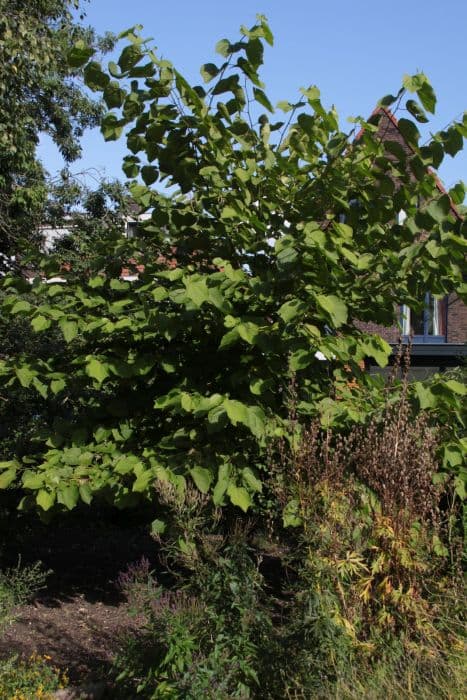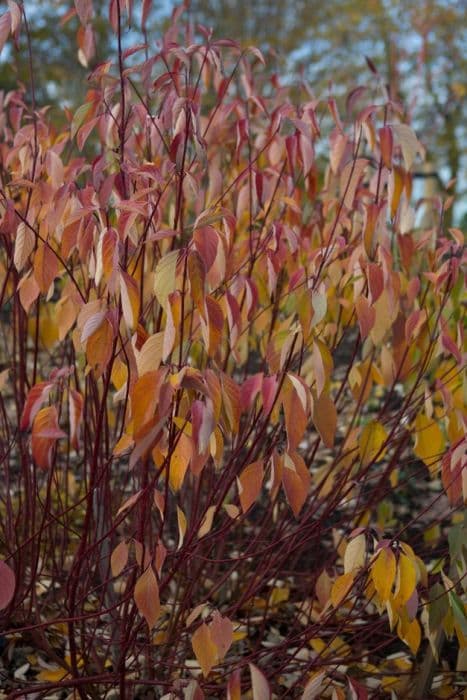Pacific Dogwood Cornus nuttallii

ABOUT
The plant commonly known as the Pacific dogwood is a beautiful and distinctive species that stands out for its impressive display of flowers and foliage. This plant's most striking feature is its large, showy bracts—often mistaken for petals—which are typically white or sometimes tinged with pink, creating a star-like surround for the smaller, inconspicuous greenish-yellow flowers at their center. These bracts bloom in the spring and often reappear in a less dramatic fashion in the late summer to early autumn. The leaves of the Pacific dogwood are simple and opposite, providing a lush background of green throughout the growing season. They are oval to ovate in shape, coming to a point at the tip, and showcase prominent veins that curve gracefully toward the leaf's margins. In the fall, the foliage transforms into vibrant shades of red to purple, adding a dramatic flare to the landscape before the leaves drop. Adding to its year-round appeal, the Pacific dogwood bears red berry-like fruits after the flowering season. These fruits are technically drupes, which means they have a fleshy body and a hard stone enclosing the seed. They provide a source of food for birds and other wildlife during the fall and winter months. The bark of the Pacific dogwood is gray to brown and develops a textured, furrowed appearance as the plant ages. During the winter, when the branches are bare, the elegantly tiered branching structure of the Pacific dogwood is revealed, offering visual interest even in the dormant season. This graceful branching pattern also makes the plant a popular choice for landscaping year-round interest.
About this plant
 Names
NamesFamily
Cornaceae
Synonyms
Pacific Dogwood, Western Dogwood, Mountain Dogwood, Nuttall's Dogwood
Common names
Cornus californica, Cornus florida var. californica, Cornus nuttallii var. californica, Cornus nuttallii subsp. californica.
 Toxicity
ToxicityTo humans
The plant commonly known as Pacific Dogwood (Cornus nuttallii) is not generally considered toxic to humans. However, as with many plants, if any parts are consumed in large quantities, they could potentially cause mild stomach upset. There are no severe toxic effects reported in humans due to the ingestion of Pacific Dogwood.
To pets
Pacific Dogwood, or Cornus nuttallii, is also not typically toxic to pets. It does not contain any known substances that are poisonous to household pets such as dogs and cats. However, ingestion of plant material could result in gastrointestinal discomfort or irritation. Watching for any sign of distress and consulting with a veterinarian if any unusual symptoms develop after ingestion is always recommended.
 Characteristics
CharacteristicsLife cycle
Perennials
Foliage type
Deciduous
Color of leaves
Green
Flower color
White
Height
20 65 (6 25 meters)
Spread
15 45 (4 5 meters)
Plant type
Tree
Hardiness zones
6
Native area
North America
Benefits
 General Benefits
General Benefits- Ecosystem support: As a native species, Cornus nuttallii, commonly known as Pacific dogwood, provides essential habitat and food for various local wildlife, including birds and insects.
- Ornamental value: Pacific dogwood is renowned for its showy white or pink flowers, which add significant aesthetic value to gardens and landscapes where it is planted.
- Seasonal Interest: This plant offers year-round visual interest through its spring blooms, summer fruits, vibrant fall foliage, and textured bark in winter.
- Shade provision: During the warmer months, Pacific dogwood trees can offer cooling shade in garden settings or in natural landscapes.
- Erosion control: With its extensive root system, the Pacific dogwood can help stabilize soil and prevent erosion on slopes and in naturalized areas.
- Climate Adaptation: Pacific dogwood is adapted to various climates within its range, making it a resilient choice for suitable planting zones.
- Cultural significance: For many indigenous communities in its native range, the Pacific dogwood has cultural importance and is used in traditional practices.
 Medical Properties
Medical Properties- This plant is not used for medical purposes.
 Air-purifying Qualities
Air-purifying QualitiesThis plant is not specifically known for air purifying qualities.
 Other Uses
Other Uses- The wood of Cornus nuttallii, known as Pacific dogwood, can be used to make tool handles due to its strength and shock resistance.
- Indigenous people traditionally used Pacific dogwood to make bows for hunting and warfare.
- The bark of Pacific dogwood can be processed to create a deep orange dye for textiles and crafts.
- The tree is utilized in habitat restoration projects to support local ecosystems and provide food for wildlife such as birds.
- Pacific dogwood is a popular ornamental plant for landscaping because of its showy flowers and bright red autumn foliage.
- The hard, dense wood can also be carved into small decorative items or used in inlay work for its beautiful grain.
- Due to its durability, the wood is sometimes used to fabricate small watercraft paddles.
- Artists may use the twigs and branches for crafting woven baskets or as framework for sculptures.
- Locals sometimes gather the fallen leaves to create a natural mulch for gardening, which can help enrich soil as they decompose.
- Tanners may use the tannin-rich bark as a mordant for leather tanning, aiding in the bonding of dye to the leather.
Interesting Facts
 Feng Shui
Feng ShuiThe Pacific Dogwood is not used in Feng Shui practice.
 Zodiac Sign Compitability
Zodiac Sign CompitabilityThe Pacific Dogwood is not used in astrology practice.
 Plant Symbolism
Plant Symbolism- Endurance and Strength: As a robust and durable plant, the Cornus nuttallii, commonly known as the Pacific Dogwood, often symbolizes endurance and strength, representing the ability to withstand various challenges.
- Purity and Innocence: The Pacific Dogwood, with its white blossoms, is commonly associated with purity and innocence, often used in cultural ceremonies and traditions to denote these values.
- Resurrection and Rebirth: Its spring blooming and prominent display during Easter times connect Pacific Dogwood with themes of resurrection and rebirth, suggesting new beginnings and hope.
- Christian Symbolism: In Christian symbolism, the Pacific Dogwood is said to be associated with the crucifixion of Jesus, its flower shape resembling a cross and the red stamens representing Jesus' blood, thus symbolizing faith and eternal life.
- Protection: Native American tribes have used the Pacific Dogwood for various medicinal purposes, which in turn lent the tree a symbolic value of protection against illness and harm.
 Water
WaterThe Pacific Dogwood should be watered deeply once a week during dry spells to maintain even moisture, which is particularly important during the first few years to establish a strong root system. The amount of water typically needed is around 1 to 1.5 gallons per watering for young trees, and for mature trees, it may require up to 5 gallons depending on the size and conditions. Make sure the soil is well-draining to prevent waterlogging. During the winter, you can reduce watering as the plant's water requirements diminish. Adjust the watering schedule based on rainfall, and always check the soil moisture level before watering.
 Light
LightThe Pacific Dogwood thrives best in a spot with dappled sunlight or partial shade. It can tolerate full sun in cooler climates, but in hotter areas, protection from intense afternoon sun is necessary to prevent leaf scorch. Ideally, position the tree where it receives morning light and shade during the hottest part of the day.
 Temperature
TemperaturePacific Dogwoods prefer a temperate climate and are hardy in USDA zones 7 through 9. They can tolerate a minimum winter temperature down to about 0 degrees Fahrenheit and a maximum summer temperature around 95 degrees Fahrenheit. The ideal growing temperatures range between 60 and 75 degrees Fahrenheit for optimal growth and flower production.
 Pruning
PruningPruning the Pacific Dogwood is important for maintaining its shape and promoting healthy growth. It should be pruned in late winter or early spring before new growth begins. Remove any dead, damaged or diseased branches, as well as any crossing or rubbing branches to enhance air circulation. Thinning out the canopy can also improve light exposure. Pruning should be done selectively to maintain a natural appearance and done every 2 to 3 years.
 Cleaning
CleaningAs needed
 Soil
SoilPacific Dogwood thrives best in a well-draining, loamy soil that is rich in organic matter. A good mix could be equal parts garden soil, compost, and coarse sand or perlite. The soil pH should be slightly acidic to neutral, ranging from 5.5 to 7.
 Repotting
RepottingPacific Dogwoods, which are typically grown outdoors and not in containers, rarely need repotting. However, if grown in a pot, repot every 2-3 years to refresh the soil and accommodate root growth.
 Humidity & Misting
Humidity & MistingPacific Dogwood prefers moderate humidity levels but is adaptable. Strive for a humidity level of around 40-60% for optimal health and growth, as is common in its natural forested habitats.
 Suitable locations
Suitable locationsIndoor
Place Pacific Dogwood by a bright window, away from hot radiators.
Outdoor
Plant Pacific Dogwood in partial shade, protect from strong winds.
Hardiness zone
6-9 USDA
 Life cycle
Life cyclePacific Dogwood (Cornus nuttallii) begins its life cycle when seeds disperse from mature fruit, usually aided by birds. Seedlings emerge in moist, fertile soil, often in partial shade beneath forest canopies. As the plant grows, it develops into a small to medium-sized deciduous tree, with a distinctive horizontal branching pattern and oval-shaped leaves. In spring to early summer, the tree produces showy white to pinkish bracts surrounding small flowers, which are pollinated by insects. Following pollination, flowers develop into red berry-like drupes that mature in late summer to fall, providing food for wildlife and completing the reproductive cycle. Throughout its life, Pacific Dogwood experiences periods of dormancy during winter before resuming growth in the spring.
 Propogation
PropogationPropogation time
Spring to early summer
The Pacific Dogwood (Cornus nuttallii) can be propagated through various methods, however, softwood cuttings are a popular way of propagation. The best time to take softwood cuttings is in late spring or early summer when new growth is still flexible and not yet hardened. To propagate by this method, a gardener would cut a 5 to 6-inch (12 to 15 centimeters) piece of softwood from the Pacific Dogwood, making sure that there are at least two sets of leaves on the cutting. The lower leaves are removed, and the cut end is dipped in a rooting hormone to stimulate root development. The cutting is then placed in a well-draining soil mix, ensuring that at least one set of leaves is above the soil level. It's crucial to maintain high humidity around the cutting, often achieved by covering the pot with a plastic bag, and to keep the soil moist but not waterlogged. With proper care, roots typically develop within a few weeks.









